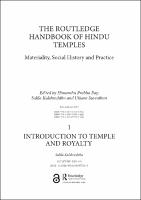Chapter 1 Introduction to Temple and Royalty
Proposal review
Abstract
How and when did the Hindu temple come to be associated with dynasties, rulers and political processes? The chapter traces the beginning of scholarship on the Hindu temple in the late 19th century and its subsequent ‘discovery’, nomenclature and listing by colonial archaeologists. In their attempt to construct a political history of India based on texts and inscriptions, scholars used temples as tangible symbols to mark the extent of empires and the political achievement of rulers. The colonial discourse on temples thus set the tone for subsequent scholarship and defined the parameters to study the Hindu temple, such that, even in the present-day scholars continue to underscore the relationship between temples, political legitimization and state formation. The current art historical scholarship continues to engage with the aesthetics and the architecture of the temple thus emphasizing the origins and construction of temples. Finally, the chapter explores new paradigms to study temple inscriptions and sculptures to establish their relationship with the communities which use the temple space.
Keywords
patronage, royalty, colonial archaeology, state formation, VastushastraDOI
10.4324/9781003097709-3ISBN
9780367563158, 9781032380223, 9781003097709Publisher
Taylor & FrancisPublisher website
https://taylorandfrancis.com/Publication date and place
2023Imprint
RoutledgeClassification
Hinduism
Religion and beliefs
Society and culture: general


 Download
Download